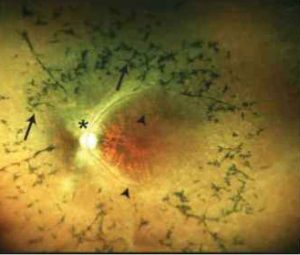A recent genetic discovery could revolutionise the diagnosis and treatment of retinitis pigmentosadegenerative eye disease affecting the retina. An international research team, led by the Italian Lorenzo Bianco, identified a new gene responsible for retinitis pigmentosa: it is IDH3G, located on the X chromosome, which could play a crucial role in this disease.
Retinitis Pigmentosa

The retinitis pigmentosa is part of a group of genetic diseases, the hereditary retinal dystrophies, which affect the retina.
Usually, the first signs appear before the age of 20 and include difficulty seeing in low light, e.g. at twilight, and a narrowing of the visual field, whereby one sees less and less to the sides, as if looking through a tunnel.
In some cases, retinitis pigmentosa not only affects vision, but may also be accompanied by other serious problems, such as deafness.
Symptoms can vary greatly between individuals, but early diagnosis is crucial to manage the progression of the disease, which in severe cases can lead to blindness.
Advances in genetic testing offer new potential for a more accurate diagnosis, which may allow a customised treatment plan to be established.
Discovery of the IDH3G Gene
The recent discovery of the IDH3G gene on the X chromosome could be a key element in the diagnosis and treatment of this complex eye disease.
Overall, retinitis pigmentosa is associated with more than 80 mutated genes, but only 4 are linked to the X chromosome, hence to the sex chromosome.
The location of the IDH3G gene on the X chromosome could explain the hereditary transmission of retinitis pigmentosa within families affected by this condition and, moreover, imply a different approach in diagnosis and treatment, considering the different presentation in males and females.
Role of Isocitrate Dehydrogenase
The IDH3G gene encodes for the gamma subunit of mitochondrial isocitrate dehydrogenase, an enzyme that is crucial for the proper functioning of retinal cells.
Isocitrate dehydrogenase is a crucial enzyme in the Krebs cycle, essential for energy production in cells, and the gamma subunit, encoded by IDH3G, plays a specific role in this process.
A mutation in the IDH3G gene could influence the metabolism of retinal cells, leading to degeneration and malfunction. This is particularly important for the light-sensitive cells of the retina, also because they require a lot of energy for their functioning.
Understanding the role of this enzyme helps to outline targeted therapeutic strategies and, potentially, could lead to the development of treatments that restore normal enzyme activity while preserving visual function.
Implications for Genetic Research
The implications of IDH3G in retinitis pigmentosa open a new chapter in genetic research. Identifying a new 'candidate' gene provides a starting point for further genetic and biological studies, as it can guide research towards other potential genes related to the disease.
The discovery of IDH3G stimulates the biomarker researchgenetics that can improve early diagnosis and prediction of disease progression. In addition, it offers a model for exploring other genetic diseases linked to the X chromosome.
Research may also focus on the development of gene therapies, which aim to correct or compensate for the genetic mutations at the root of the problem. These therapies could offer a lasting solution for patients.
Impact of Discovery on Diagnosis
The identification of IDH3G offers a new perspective on the genetic diagnosis of retinitis pigmentosa. The advanced DNA sequencing techniques could now include this gene in test panels, improving diagnostic accuracy.
Genetic tests that include IDH3G can identify specific mutations, allowing early diagnosis. This is particularly important for family genetic counselling, helping to predict the likelihood of disease transmission.
In the future, the use of cutting-edge technologies could reduce costs of genetic tests, making them more accessible to a wide range of patients.
Specialists could adapt the standard diagnostic protocols to include testing for this gene, improving clinical decision-making.
L'updating the guidelines could encourage the adoption of more comprehensive genetic testing in clinical practice, making the diagnosis of retinitis pigmentosa more accurate and timely.
The integration of genetic research into everyday clinical care could lead to more personalised care, better responding to the individual needs of patients.
Perspectives for New Therapies
The discovery of IDH3G paves the way for new targeted therapies. Future research could focus on treatments that restore isocitrate dehydrogenase gamma function, correcting the metabolic defect underlying the disease.
Gene therapies represent a promising prospect, with the possibility of directly modifying the altered gene. In addition, drugs that modulate enzyme activity could be developed to slow or stop disease progression.
Future of Eye Disease Research
The discovery of IDH3G not only influences retinitis pigmentosa, but also stimulates wider research into eye diseases, promoting collaboration and innovation.
International collaborations are crucial for advancing genetic research in eye diseases. Sharing data and resources between institutions around the world accelerates the discovery of new treatments.
Global cooperation allows access to diverse genetic populations, enriching our understanding of gene variations and their clinical implications. This collaborative approach can guide the development of more effective treatments.
In addition, working together on international research projects makes it possible to overcome financial and technical barriers, leading to faster discoveries.
Cutting-edge technological developments
The evolution of genetic sequencing technologies has a direct impact on eye disease research. Instruments such as the next-generation sequencing allow large amounts of genetic data to be analysed rapidly.
These technologies make it possible to discover new genes associated with eye diseases, improving our understanding of the genetic basis of these conditions. They also facilitate the development of more sophisticated genetic tests.
Ongoing Research Projects
Several research projects are underway to further explore the implications of IDH3G and other retinitis pigmentosa-related genes. These studies aim to:
- Better understand the role of IDH3G in retinal metabolism.
- Developing animal models for studying the disease.
- Testing new gene and drug therapies.
These projects represent an important step towards improving treatment options for patients, offering hope for the future.
Conclusions and Perspectives
Continued research is vital to fully understand the implications of the IDH3G gene and to develop effective treatments.
Investment in genetic research can lead to revolutionary discoveries, improving the lives of millions of people around the world. It is crucial to promote education and awareness of the importance of eye research.
For patients and their families, the discovery of IDH3G is a message of hope and confidence.
Families can benefit from more precise genetic counselling, enabling informed family planning and early disease management.
This scientific progress offers new hope for a better future, in which eye diseases can be better understood and treated demonstrates the human capacity to overcome challenges through research and innovation.
Confidence in scientific progress inspires and motivates continuous efforts to improve eye health globally.
In conclusion, the discovery of IDH3G is only the beginning of a promising journey in the field of ocular genetics.
Bianco L, Navarro J, Michiels C, et al. Identification of IDH3G, encoding the gamma subunit of mitochondrial isocitrate dehydrogenase, as a novel candidate gene for X-linked retinitis pigmentosa. Genet Med. 2025 Mar 19;27(6):101418. doi: 10.1016/j.gim.2025.101418. Epub ahead of print. PMID: 40119724.
